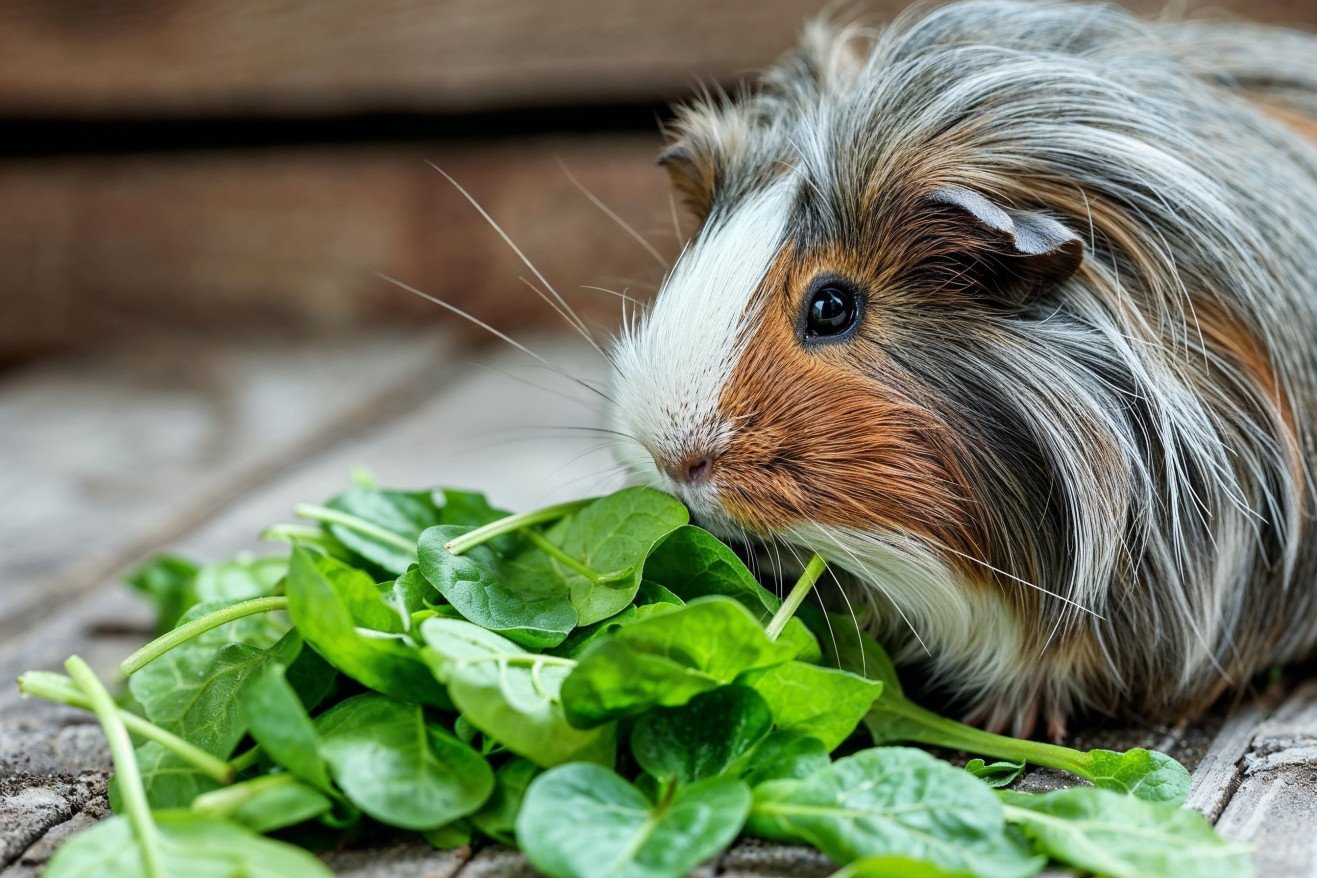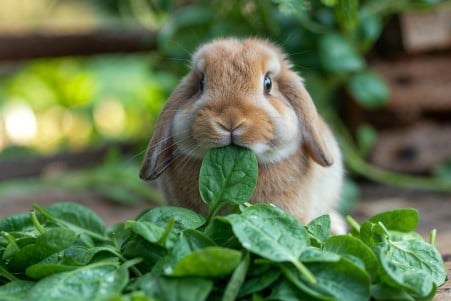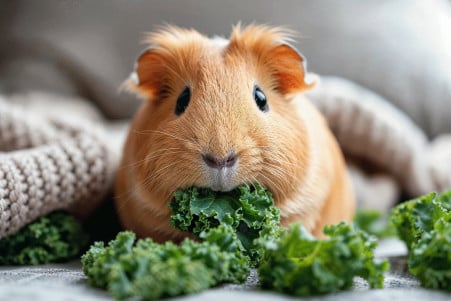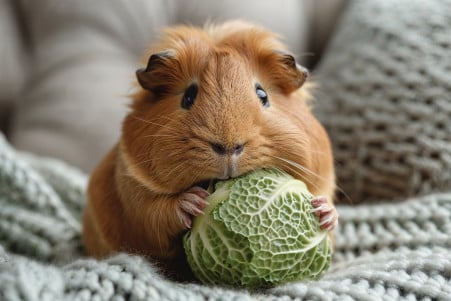Can Guinea Pigs Eat Spinach? A Guide to Safe Feeding Practices
23 January 2024 • Updated 28 January 2024

When it comes to what to feed your guinea pig, it’s easy to get lost in the salad aisle. Spinach is safe for guinea pigs to eat in moderation and is a good source of important nutrients like Vitamin C.
However, spinach is also high in calcium and oxalic acid, which can cause problems like kidney stones if guinea pigs eat too much. Because of this, spinach should be fed to guinea pigs occasionally and as part of a balanced diet.
In order to help you make the best decisions for your guinea pigs, we’ll cover a variety of topics, including nutritional studies, advice from veterinarians, and best practices that are specific to the care of guinea pigs.
With this information in mind, we’ll discuss the pros and cons of feeding guinea pigs spinach, focusing on the importance of a balanced diet and feeding spinach in moderation. Our hope is that this information will give you a science-based understanding that will help you make the best choices for your guinea pig’s diet and health.
Can guinea pigs eat spinach?
The Good Stuff: Nutritional Facts of Spinach for Guinea Pigs
Spinach is a nutritional powerhouse that contains a variety of vitamins and minerals that are important for guinea pig health. According to Precisely Pets, spinach is high in Vitamin A, which is important for maintaining good eyesight in guinea pigs, and Vitamin K1, which is necessary for blood clotting. Spinach is also a great source of folate and contains minerals like iron, potassium, and magnesium, which are important for various physiological processes.
Vitamin C is especially important because, like humans, guinea pigs can’t produce this essential vitamin on their own. According to Pet Keen, spinach helps meet this need with its vitamin C content, which is important for preventing scurvy and supporting the immune system in guinea pigs.
In addition, a study published in Science Direct says that spinach is a good source of antioxidants like lutein and zeaxanthin, which help protect against age-related eye diseases, and nitrates, which may help support heart health. Fresh vegetables, which are an important part of a guinea pig’s diet, not only provide hydration but also important nutrients that may not be found in hay.
As a result, there are many benefits to feeding spinach to your guinea pig. However, it’s important to make sure that these nutrient-dense foods are balanced with other parts of their diet to make sure that they’re getting everything they need for a well-rounded and healthy diet.
The Balancing Act: Calcium and Oxalic Acid in Spinach for Guinea Pigs
Calcium is an important mineral for guinea pigs, helping to build strong bones and teeth, but as with many things, it’s important to consume it in moderation. Too much calcium can cause urinary issues, including painful kidney stones.
Spinach, while healthy, is high in calcium and oxalic acid, which can make this problem worse. An article by Livestrong explains that the body can only absorb a small amount of the calcium in spinach because oxalates in the vegetable bind to the mineral, making it less available for the body to use.
Oxalic acid, which is found in high levels in spinach, can also interfere with the body’s ability to absorb other minerals, leading to deficiencies and other health problems, including kidney stones.
A study published in the Asia Pacific Journal of Clinical Nutrition found that oxalates in spinach inhibit the absorption of calcium and can also bind to calcium in other foods that are eaten at the same time, reducing the overall absorption of the mineral.
To avoid these problems, it’s important for guinea pig owners to know the signs of too much calcium in their pets, including urine that’s gritty or that seems to cause the animal pain.
By limiting the amount of spinach they eat and making sure they eat a variety of other vegetables, owners can make sure their guinea pigs get the nutrients they need without the health problems that can come from overdoing it. This will also ensure that their pets have a varied diet.
A Rainbow of Greens: Other Leafy Greens to Try
If you want to add more variety to your guinea pig’s diet, there are other leafy greens that are lower in calcium and oxalic acid than spinach. According to Oxbow Animal Health, some of the leafy greens that are lower in calcium and oxalic acid than spinach include Romaine, Butterhead, and Red or Green leaf lettuce.
Other options like arugula, endive, and turnip greens can also offer the nutrients your guinea pig needs without the risk of oxalate-related health issues.
These other options also offer a similar range of vitamins and minerals, but with a better balance for your guinea pig. For example, bell peppers, while not a leafy green, are a great source of vitamin C and can be a good addition to your guinea pig’s diet, especially since they offer a different texture and taste.
In addition to the nutritional benefits, offering a variety of greens can also help stimulate your guinea pig’s senses and prevent them from becoming picky eaters. By rotating the greens you offer and introducing new ones slowly, you can help ensure that your guinea pig gets a wide range of nutrients and avoid overdoing it on any one nutrient, which can lead to health issues.
Always introduce new foods slowly to give your guinea pig’s digestive system time to adjust and to help ensure overall digestive health.
Following the Guinea Pig’s Digestive Path: Spinach Digestion
The guinea pig’s digestive tract is well-suited to the high-fiber herbivorous diet it eats, and it’s quite fascinating. In this little animal, a large, well-developed cecum is where fiber-rich foods like spinach are fermented by helpful bacteria to aid in digestion and nutrient absorption.
As explained by NCBI Bookshelf, guinea pigs eat a lot of plant material and rely on their gut microbiota to break down things that they can’t digest on their own. This is important for creating B vitamins and essential amino acids, which are then reabsorbed through coprophagy—eating of their fecal pellets.
The metabolism of calcium and oxalates, which are both found in spinach, is a delicate balance. Oxalates can bind to calcium, which can lead to the formation of crystals that can cause kidney stones.
As explained by Guinea Lynx, research has shown that guinea pigs can handle calcium and oxalates well, but an overload, especially from high-oxalate foods, can lead to imbalances that can cause health problems. A study published by PMC explains how the metabolism of oxalates by gut bacteria can impact this, showing that a healthy gut microbiota is important for the health of guinea pigs.
Given their fiber needs and vitamin C requirements, spinach can be part of a guinea pig’s diet. However, it’s important to feed it in moderation to avoid upsetting the balance of their digestive system and to avoid the potential negative effects of too much calcium and oxalates. When feeding new foods like spinach, it’s important to do so gradually to ensure that the guinea pig’s diet remains nutritionally balanced and to avoid digestive upset.
Best Practices: How Much Spinach Can Guinea Pigs Eat and How to Add Variety to Their Diet
Guinea pigs need a high-fiber diet, with hay as the main component and fresh vegetables as a supplement. VCA Animal Hospitals explains that spinach is high in calcium and oxalic acid, so it should be fed in limited amounts. To avoid health issues, feed your guinea pig small amounts of spinach, such as one to two leaves once or twice a week.
When feeding vegetables, aim for one cup per two pounds of your guinea pig’s weight per day, with leafy greens making up the bulk of the vegetables.
When you start feeding your guinea pig spinach, do so gradually so you can see how your guinea pig reacts to it. UK Pet Food recommends introducing new vegetables one at a time and in small amounts so your guinea pig’s digestive system can get used to them. Watch your guinea pig for any signs of digestive upset or changes in eating habits so you can evaluate their general well-being.
To make sure your guinea pig gets a well-rounded diet, feed them a variety of vegetables, including those that are high in Vitamin C, like bell peppers, and those that are low in calcium, like Romaine lettuce and cilantro, according to the RSPCA.
You should also talk to a vet to find out what your guinea pig’s specific dietary requirements are and how you can adjust their diet to meet them so they can be as healthy and well-nourished as possible.
Final Thoughts: Can Guinea Pigs Eat Spinach?
When it comes to providing your guinea pig with a healthy diet, spinach is a bit of a double-edged sword. We’ve learned that while spinach is a great source of important vitamins and minerals, especially vitamin C, it’s also high in calcium and oxalic acid, which can be problematic.
The key to feeding your guinea pig spinach is to do so in moderation. You can add small amounts of spinach to your guinea pig’s diet occasionally without worrying about the health issues that can come from feeding it too much.
The key to a healthy guinea pig diet is balance and variety. It’s important for pet owners to be aware of the nutritional value of the foods they feed their pets, including the benefits and risks of spinach, and to feed their pets a variety of vegetables to ensure they get the nutrients they need.
It’s also important for pet owners to stay informed and talk to their vets regularly to make sure they’re doing everything they can to keep their pets healthy. In the end, let’s all commit to providing our guinea pigs with the best care possible by staying informed and making sure they have everything they need to be happy and healthy.


